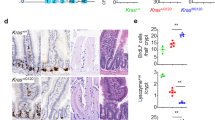Abstract
The GNASR201 gain-of-function mutation is the single most frequent cancer-causing mutation across all heterotrimeric G proteins, driving oncogenesis in various low-grade/benign gastrointestinal and pancreatic tumors. In this study, we investigated the role of GNAS and its product Gαs in tumor progression using peritoneal models of colorectal cancer (CRC). GNAS was knocked out in multiple CRC cell lines harboring GNASR201C/H mutations (KM12, SNU175, SKCO1), leading to decreased cell-growth in 2D and 3D organoid models. Nude mice were peritoneally injected with GNAS-knockout KM12 cells, leading to a decrease in tumor growth and drastically improved survival at 7 weeks. Supporting these findings, GNAS overexpression in LS174T cells led to increased cell-growth in 2D and 3D organoid models, and increased tumor growth in PDX mouse models. GNAS knockout decreased levels of cyclic AMP in KM12 cells, and molecular profiling identified phosphorylation of β-catenin and activation of its targets as critical downstream effects of mutant GNAS signaling. Supporting these findings, chemical inhibition of both PKA and β-catenin reduced growth of GNAS mutant organoids. Our findings demonstrate oncogene addiction to GNAS in peritoneal models of GNASR201C/H tumors, which signal through the cAMP/PKA and Wnt/β-catenin pathways. Thus, GNAS and its downstream mediators are promising therapeutic targets for GNAS mutant tumors.
This is a preview of subscription content, access via your institution
Access options
Subscribe to this journal
Receive 50 print issues and online access
$259.00 per year
only $5.18 per issue
Buy this article
- Purchase on Springer Link
- Instant access to full article PDF
Prices may be subject to local taxes which are calculated during checkout





Similar content being viewed by others
Data availability
All data supporting the findings of this study are available within the paper and its supplementary information files, gene expression data will be uploaded to GEO. Data generated for this study are available through the Gene Expression Omnibus (GEO). Accession number: GSE208278.
References
O’Hayre M, Degese MS, Gutkind JS. Novel insights into G protein and G protein-coupled receptor signaling in cancer. Curr Opin Cell Biol. 2014;27:126–35.
Rosenbaum DM, Rasmussen SGF, Kobilka BK. The structure and function of G-protein-coupled receptors. Nature 2009;459:356–63.
Landis CA, Masters SB, Spada A, Pace AM, Bourne HR, Vallar L. GTPase inhibiting mutations activate the alpha chain of Gs and stimulate adenylyl cyclase in human pituitary tumours. Nature 1989;340:692–6.
Hu Q, Shokat KM. Disease-Causing Mutations in the G Protein Gαs Subvert the Roles of GDP and GTP. Cell 2018;173:1254–64.e11.
Weinstein LS, Liu J, Sakamoto A, Xie T, Chen M. Minireview: GNAS: normal and abnormal functions. Endocrinology 2004;145:5459–64.
Ideno N, Yamaguchi H, Ghosh B, Gupta S, Okumura T, Steffen DJ, et al. GNASR201C Induces Pancreatic Cystic Neoplasms in Mice That Express Activated KRAS by Inhibiting YAP1 Signaling. Gastroenterology 2018;155:1593–607.e12.
Patra KC, Kato Y, Mizukami Y, Widholz S, Boukhali M, Revenco I, et al. Mutant GNAS drives pancreatic tumourigenesis by inducing PKA-mediated SIK suppression and reprogramming lipid metabolism. Nat Cell Biol. 2018;20:811–22.
Ang CSP, Shen JP, Hardy-Abeloos CJ, Huang JK, Ross JS, Miller VA, et al. Genomic Landscape of Appendiceal Neoplasms. JCO Precision Oncol. 2018;2:1–18.
Sassone-Corsi P. The Cyclic AMP Pathway. Cold Spring Harbor Perspectives in. Biology 2012;4:a011148.
Rosciglione S, Thériault C, Boily M-O, Paquette M, Lavoie C. Gαs regulates the post-endocytic sorting of G protein-coupled receptors. Nat Commun. 2014;5:4556.
Schatoff EM, Leach BI, Dow LE. Wnt Signaling and Colorectal Cancer. Curr Colorectal Cancer Rep. 2017;13:101–10.
Vogelstein B, Papadopoulos N, Velculescu VE, Zhou S, Diaz LA, Kinzler KW. Cancer genome landscapes. Science 2013;339:1546–58.
Wang S, Ma J, Zhang W, Shen JP, Huang J, Peng J, et al. Typing tumors using pathways selected by somatic evolution. Nat Commun. 2018;9:4159.
Garcia-Murillas I, Sharpe R, Pearson A, Campbell J, Natrajan R, Ashworth A, et al. An siRNA screen identifies the GNAS locus as a driver in 20q amplified breast cancer. Oncogene 2014;33:2478–86.
Faias S, Duarte M, Pereira L, Chaves P, Cravo M, Dias Pereira A, et al. Methylation changes at the GNAS imprinted locus in pancreatic cystic neoplasms are important for the diagnosis of malignant cysts. World J Gastrointest Oncol. 2020;12:1056–64.
Gao J, Aksoy BA, Dogrusoz U, Dresdner G, Gross B, Sumer SO, et al. Integrative analysis of complex cancer genomics and clinical profiles using the cBioPortal. Sci Signal. 2013;6:pl1.
Cerami E, Gao J, Dogrusoz U, Gross BE, Sumer SO, Aksoy BA, et al. The cBio cancer genomics portal: an open platform for exploring multidimensional cancer genomics data. Cancer Discov. 2012;2:401–4.
Patel A, Cushman-Vokoun AM, Alex B, Sleightholm R, Foster JM. Mutations in GI cancers with peritoneal metastasis. J Clin Oncol. 2015;33:e22030-e.
Raghav K, Shen JP, Jácome AA, Guerra JL, Scally CP, Taggart MW, et al. Integrated clinico-molecular profiling of appendiceal adenocarcinoma reveals a unique grade-driven entity distinct from colorectal cancer. Br J Cancer. 2020;123:1262–70.
Lin Y-L, Ma R, Li Y. The biological basis and function of GNAS mutation in pseudomyxoma peritonei: a review. J Cancer Res Clin Oncol. 2020;146:2179–88.
Komatsu H, Tanji E, Sakata N, Aoki T, Motoi F, Naitoh T, et al. A GNAS Mutation Found in Pancreatic Intraductal Papillary Mucinous Neoplasms Induces Drastic Alterations of Gene Expression Profiles with Upregulation of Mucin Genes. PloS ONE. 2014;9:e87875.
Nishikawa G, Sekine S, Ogawa R, Matsubara A, Mori T, Taniguchi H, et al. Frequent GNAS mutations in low-grade appendiceal mucinous neoplasms. Br J Cancer. 2013;108:951–8.
Arang N, Gutkind JSG. Protein‐Coupled receptors and heterotrimeric G proteins as cancer drivers. FEBS Lett. 2020;594:4201–32.
Lochner A, Moolman JA. The many faces of H89: a review. Cardiovasc Drug Rev. 2006;24:261–74.
Taurin S, Sandbo N, Qin Y, Browning D, Dulin NO. Phosphorylation of β-Catenin by Cyclic AMP-dependent Protein Kinase. J Biol Chem. 2006;281:9971–6.
Jung Y-S, Park J-I. Wnt signaling in cancer: therapeutic targeting of Wnt signaling beyond β-catenin and the destruction complex. Exp Mol Med. 2020;52:183–91.
Parsons MJ, Tammela T, Dow LE. WNT as a Driver and Dependency in Cancer. Cancer Discov. 2021;11:2413–29.
Khan SK, Yadav PS, Elliott G, Hu DZ, Xu R, Yang Y. Induced GnasR201H expression from the endogenous Gnas locus causes fibrous dysplasia by up-regulating Wnt/β-catenin signaling. Proc Natl Acad Sci USA. 2018;115:E418–E27.
Stein MK, Williard FW, Xiu J, Tsao MW, Martin MG, Deschner BW, et al. Comprehensive tumor profiling reveals unique molecular differences between peritoneal metastases and primary colorectal adenocarcinoma. J Surg Oncol. 2020;121:1320–8.
Stein MK, Williard FW, Tsao M, Deschner B, Dickson PV, Glazer ES, et al. Molecular comparison of primary colorectal cancer (pCRC) with peritoneal metastases (PM). J Clin Oncol. 2019;37:498-.
Hosoda W, Sasaki E, Murakami Y, Yamao K, Shimizu Y, Yatabe Y. GNAS mutation is a frequent event in pancreatic intraductal papillary mucinous neoplasms and associated adenocarcinomas. Virchows Arch: Int J Pathol. 2015;466:665–74.
Khan M, Loree JM, Advani SM, Ning J, Li W, Pereira AAL, et al. Prognostic Implications of Mucinous Differentiation in Metastatic Colorectal Carcinoma Can Be Explained by Distinct Molecular and Clinicopathologic Characteristics. Clin Colorectal cancer. 2018;17:e699–e709.
Ritterhouse LL, Vivero M, Mino-Kenudson M, Sholl LM, Iafrate AJ, Nardi V, et al. GNAS mutations in primary mucinous and non-mucinous lung adenocarcinomas. Mod Pathol. 2017;30:1720–7.
Kufe DW. Mucins in cancer: function, prognosis and therapy. Nat Rev Cancer. 2009;9:874–85.
Zhang H, Kong Q, Wang J, Jiang Y, Hua H. Complex roles of cAMP–PKA–CREB signaling in cancer. Exp Hematol Oncol. 2020;9:32.
Goh G, Scholl UI, Healy JM, Choi M, Prasad ML, Nelson-Williams C, et al. Recurrent activating mutation in PRKACA in cortisol-producing adrenal tumors. Nat Genet. 2014;46:613–7.
Hino S-i, Tanji C, Nakayama KI, Kikuchi A. Phosphorylation of β-Catenin by Cyclic AMP-Dependent Protein Kinase Stabilizes β-Catenin through Inhibition of Its Ubiquitination. Mol Cell Biol. 2005;25:9063–72.
Sastre-Perona A, Santisteban P. Role of the Wnt Pathway in Thyroid Cancer. Front Endocrinol. 2012;3:31.
Regard JB, Cherman N, Palmer D, Kuznetsov SA, Celi FS, Guettier J-M, et al. Wnt/ -catenin signaling is differentially regulated by G proteins and contributes to fibrous dysplasia. Proc Natl Acad Sci. 2011;108:20101–6.
Gueorguiev M, Grossman AB. Pituitary gland and β-catenin signaling: from ontogeny to oncogenesis. Pituitary 2009;12:245–55.
Nomura R, Saito T, Mitomi H, Hidaka Y, Lee S-y, Watanabe S, et al. GNAS mutation as an alternative mechanism of activation of the Wnt/β-catenin signaling pathway in gastric adenocarcinoma of the fundic gland type. Hum Pathol. 2014;45:2488–96.
Wilson CH, McIntyre RE, Arends MJ, Adams DJ. The activating mutation R201C in GNAS promotes intestinal tumourigenesis in Apc(Min/+) mice through activation of Wnt and ERK1/2 MAPK pathways. Oncogene 2010;29:4567–75.
Tissier F, Cavard C, Groussin L, Perlemoine K, Fumey G, Hagneré A-M, et al. Mutations of β-Catenin in Adrenocortical Tumors: activation of the Wnt Signaling Pathway Is a Frequent Event in both Benign and Malignant Adrenocortical Tumors. Cancer Res. 2005;65:7622–7.
Almeida MQ, Stratakis CA. How does cAMP/protein kinase A signaling lead to tumors in the adrenal cortex and other tissues? Mol Cell Endocrinol. 2011;336:162–8.
Innamorati G, Wilkie TM, Kantheti HS, Valenti MT, Dalle Carbonare L, Giacomello L, et al. The curious case of Galphas gain-of-function in neoplasia. BMC Cancer. 2018;18:293.
Dai SA, Hu Q, Gao R, Lazar A, Zhang Z, von Zastrow M, et al. A GTP-state specific cyclic peptide inhibitor of the GTPase Gαs. bioRxiv. 2020:2020.04.25.054080.
Onken MD, Makepeace CM, Kaltenbronn KM, Choi J, Hernandez-Aya L, Weilbaecher KN, et al. Targeting primary and metastatic uveal melanoma with a G protein inhibitor. J Biol Chem. 2021;296:100403.
Coles GL, Cristea S, Webber JT, Levin RS, Moss SM, He A, et al. Unbiased Proteomic Profiling Uncovers a Targetable GNAS/PKA/PP2A Axis in Small Cell Lung Cancer Stem Cells. Cancer Cell. 2020;38:129–43.e7.
Franken NA, Rodermond HM, Stap J, Haveman J, van Bree C. Clonogenic assay of cells in vitro. Nat Protoc. 2006;1:2315–9.
Dobin A, Davis CA, Schlesinger F, Drenkow J, Zaleski C, Jha S, et al. STAR: ultrafast universal RNA-seq aligner. Bioinformatics 2013;29:15–21.
Tischler G, Leonard S. biobambam: tools for read pair collation based algorithms on BAM files. Source Code Biol Med. 2014;9:13.
Harrow J, Frankish A, Gonzalez JM, Tapanari E, Diekhans M, Kokocinski F, et al. GENCODE: the reference human genome annotation for The ENCODE Project. Genome Res. 2012;22:1760–74.
Anders S, Pyl PT, Huber W. HTSeq-a Python framework to work with high-throughput sequencing data. Bioinformatics 2015;31:166–9.
Conway T, Wazny J, Bromage A, Tymms M, Sooraj D, Williams ED, et al. Xenome-a tool for classifying reads from xenograft samples. Bioinformatics 2012;28:i172–8.
Yang IS, Son H, Kim S, Kim S. ISOexpresso: a web-based platform for isoform-level expression analysis in human cancer. BMC Genom. 2016;17:631.
Anders S, Huber W. Differential expression analysis for sequence count data. Genom Biol. 2010;11:R106.
Subramanian A, Tamayo P, Mootha VK, Mukherjee S, Ebert BL, Gillette MA, et al. Gene set enrichment analysis: a knowledge-based approach for interpreting genome-wide expression profiles. Proc Natl Acad Sci USA. 2005;102:15545–50.
Liberzon A, Birger C, Thorvaldsdottir H, Ghandi M, Mesirov JP, Tamayo P. The Molecular Signatures Database (MSigDB) hallmark gene set collection. Cell Syst. 2015;1:417–25.
Kimbrel EA, Davis TN, Bradner JE, Kung AL. In vivo pharmacodynamic imaging of proteasome inhibition. Mol Imaging. 2009;8:140–7.
Acknowledgements
This work was supported by the National Cancer Institute (L30 CA171000 and K22 CA234406 to JPS, and the Cancer Center Support Grant (P30 CA016672), the Cancer Prevention & Research Institute of Texas (RR180035 to JPS, JPS is a CPRIT Scholar in Cancer Research), and the Col. Daniel Connelly Memorial Fund. We thank the following core facilities at MD Anderson Cancer Center for their services used in this study: Reverse Phase Protein Array Core (Supported by NCI grant # CA16672 and #R50CA221675), Advanced Technology Genomics Core (Supported by NCI Grant CA016672(ATGC)), Biospecimen Extraction Facility for sample processing and DNA/RNA/protein extraction, and Small Animal Imaging Facility (Supported by the Cancer Center Support Grant CA16672) for in vivo live imaging. In addition, data generated by TCGA Research Network: https://www.cancer.gov/tcga was used in this publication. We also acknowledge Dr Kenna Shaw and data integration and clinical team members from the Sheikh Khalifa Bin Zayed Al Nahyan Institute for Personalized Cancer Therapy, supported by the Khalifa Bin Zayed Al Nahyan Foundation, for building and maintaining the MOCLIP database.
Author information
Authors and Affiliations
Contributions
AM, II, and VH conceived, designed, and performed all experiments and wrote the paper. SC and YG performed computational analysis and helped write the paper. PD performed animal experiments, and NF quantified and analyzed immunohistochemistry data. JPS conceived, designed and supervised the study, and wrote the paper.
Corresponding author
Ethics declarations
Competing interests
The authors declare no competing interests.
Additional information
Publisher’s note Springer Nature remains neutral with regard to jurisdictional claims in published maps and institutional affiliations.
Rights and permissions
About this article
Cite this article
More, A., Ito, I., Haridas, V. et al. Oncogene addiction to GNAS in GNASR201 mutant tumors. Oncogene 41, 4159–4168 (2022). https://doi.org/10.1038/s41388-022-02388-6
Received:
Revised:
Accepted:
Published:
Issue Date:
DOI: https://doi.org/10.1038/s41388-022-02388-6



